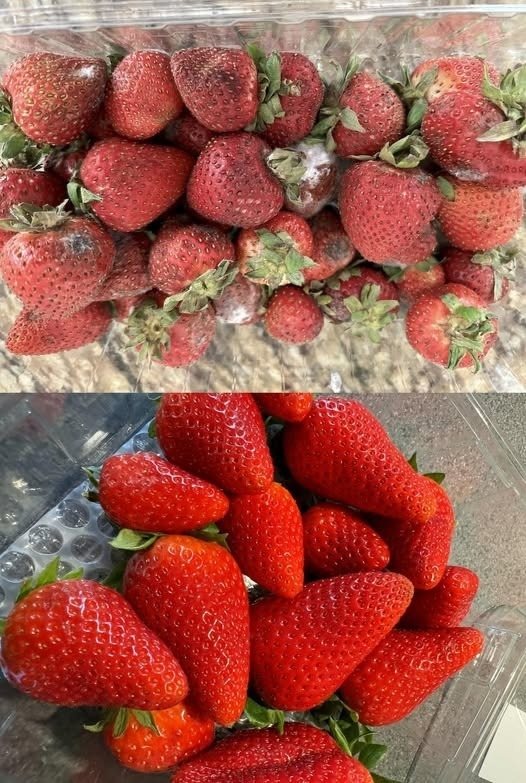ADVERTISEMENT
#### Tips for Freezing Strawberries:
– **Whole vs. Sliced**: You can freeze strawberries whole or sliced. If you plan to use them for smoothies, slicing them beforehand can save you time later.
– **Sugar or Syrup**: If you want to sweeten your strawberries before freezing them, toss them with a small amount of sugar or a simple syrup. This will enhance their flavor once they thaw.
– **Label and Date**: Be sure to label the bag with the date so you know when the strawberries were frozen. Frozen strawberries typically last for 6-8 months.
### 3. **Storing Strawberries at Room Temperature (Short-Term)**
If you plan to consume your strawberries within a day or two, you can store them at room temperature. However, you must be mindful of the moisture levels and avoid stacking them, as this can cause bruising.
#### How to Store Strawberries at Room Temperature:
1. **Place in a Single Layer**: Arrange strawberries in a single layer on a plate or shallow dish. This helps prevent bruising and allows air to circulate around them.
2. **Store in a Cool Area**: Keep the strawberries in a cool area away from direct sunlight. The fruit should not be exposed to heat, as this will speed up the ripening process and cause them to spoil quickly.
3. **Use Quickly**: Strawberries stored at room temperature should be eaten within a day or two for the best quality. Any longer, and they may become mushy and overripe.
### 4. **The Paper Towel Trick**
Another simple method to extend the freshness of strawberries is the “paper towel trick.” This technique helps reduce moisture buildup, which is a leading cause of mold growth.
#### How the Paper Towel Trick Works:
1. **Place Strawberries in a Container**: Place the strawberries in a container with some space between them.
2. **Add a Layer of Paper Towels**: Lay a clean paper towel over the strawberries in the container. The paper towel will absorb excess moisture that the berries release.
3. **Store in the Refrigerator**: Close the container and refrigerate the strawberries. The paper towel will help keep them dry and fresh for a longer period.
### 5. **Vinegar Solution (for Mold Prevention)**
A popular technique for extending the shelf life of strawberries is using a vinegar solution. The acetic acid in vinegar helps kill mold spores, preventing the growth of mold on strawberries.
#### How to Use a Vinegar Solution:
1. **Prepare the Solution**: Mix 1 part white vinegar to 3 parts water in a large bowl.
2. **Soak the Strawberries**: Dip the strawberries into the vinegar solution and gently swish them around.
3. **Rinse and Dry**: After a few minutes, rinse the strawberries under cool water to remove the vinegar smell. Dry them thoroughly with a clean towel.
4. **Store Properly**: After drying, store the strawberries in a dry container in the refrigerator.
## How to Tell When Strawberries Have Gone Bad
Even with the best storage techniques, strawberries can still spoil over time. It’s important to know how to recognize when they’re no longer safe or enjoyable to eat.
### Signs of Spoilage:
– **Mold**: If you notice any fuzzy, white, or grayish spots on the strawberries, they have likely developed mold and should be discarded.
– **Softness**: Overripe strawberries become mushy and lose their firmness. If the fruit is too soft, it is best to discard it.
– **Off-Smell**: Fresh strawberries have a sweet, fruity aroma. If they develop a sour or fermented smell, they are no longer fresh.
– **Darkened or Leaky Spots**: Any dark spots or leaks in the strawberries are signs that the fruit is deteriorating and should not be eaten.
## Conclusion: Making the Most of Your Strawberries
By following the proper storage techniques and handling strawberries with care, you can enjoy this delicious fruit for a longer period and reduce waste. Whether you prefer to store strawberries in the refrigerator, freeze them for later, or use simple methods like the paper towel trick, you can ensure that your strawberries remain fresh and tasty for days to come.
With the right knowledge and a few practical tips, you’ll be able to savor the sweetness of fresh strawberries all year long—whether you enjoy them on their own, as part of a dessert, or in your favorite recipes.
